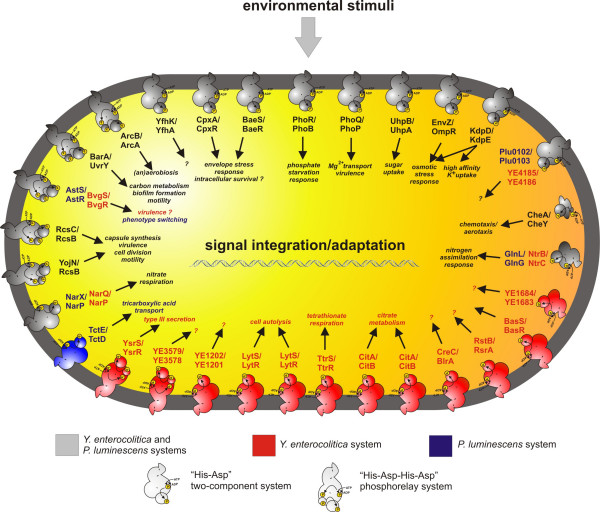Figure 2.
Two-component systems in P. luminescens and Y. enterocolitica. 18 TCSs are present in P. luminescens, and 28 TCSs in Y. enterocolitica. Both organisms share 17 of these systems (grey colour). One is singular to P. luminescens (coloured in blue), but 11 to Y. enterocolitica (red colour). Basic TCSs (His-Asp phosphotransfer) and complex phosphorelay systems (His-Asp-His-Asp phosphorelay) are distinguished by different drawings. The 17 systems shared by the two pathogens, and also present in other (enteric) bacteria, are CpxAR and BaeSR (Envelope stress, [131]), CheAYW (motility, [132]), PhoRB (Phosphate starvation, [133]), UhpBA (Sugar uptake, [134]), ArcBA (aerob/anaerob respiration, [135]), BarA/UvrY (carbon metabolism, motility, biofilm formation, [136]), RcsC/RcsD (capsular synthesis, virulence, [137]), KdpD/KdpE (K+-limitation, osmotic stress, [138]), EnvZ/OmpR (osmotic stress, [139]), NtrB/NtrC and GlnL/GlnG (nitrogen assimilation, [140]), PhoQ/PhoP (Mg2+ sensing, virulence, [141]), BvgSR/AstSR (virulence, phenotypic switching, [28, 142]), RcsC/RcsB and YojN/RcsB (capsule synthesis, cell division, motility, virulence, [143, 144]), and YfhK/YfhA, a system of unknown function. Furthermore, a TCS exists in both organisms which is unique for the genera Photorhabdus and Yersinia and cannot be found with a comparable homology/identity degree in any other yet known organism (Plu0102/Plu0103 and YE4185/YE4186). The 11 systems which are present in Y. enterocolitica, but not in P. luminescens, are YsrS/YsrR (activation of a Yersinia specific type-III secretion system, [87]), LytS/LytR (cell autolysis, [145]), CitA/CitB (citrate metabolism, [146]), TtrS/TtrR (tetrathionate respiration, [99]), and six systems of unknown function (YE3579/YE3578, YE1202/YE1201, YE1684/YE1683, CreC/BlrA, RstB/RstA, and BasS/BasR).

